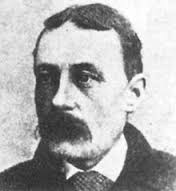Doctor Campbell Mellis Douglas was born in Grosse Ile, Quebec on August 5, 1840. In his youth he attended St. John's college and Laval University. He latter went to Scotland and attended Edinburgh School of Medicine where he received a Doctor of Medicine Degree in 1861 and became a Fellow of the Royal college of Surgeons.
Campbell Mellis Douglas enlisted in the British Medical Service in 1862 and was posted to the 2nd Battalion 24th Regiment of Foot at Ragoon (also known as Yangon) Burma. By 1867 he had risen to the Rank of Major. Dr. Douglas was serving as Assistant Surgeon in charge of four privates of the 2nd Battalion 24th Regiment of foot (known as the South Wales Borderers) who were involved in a rescue at sea during a fierce storm.
The Victoria Cross citation published December 17, 1867, in the London Gazzette stated:
"For the very gallant manner in which on 7th May, 1867 they risked their lives in manning a boat and proceeding through dangerous surf to rescue some of their comrades who formed part of an expedition which had been sent to the Island of Andaman, by Order of the Chief, Commissioner of British Burmah, with the view of ascertaining the fate of the Commander and seven of the crew of the ship "Assam Valley," who had landed there and were supposed to have been murdered by the natives.The officer who commanded the troops on the occasion reports: About an hour later in the day, Dr. Douglas, 2nd Battalion, 24th regiment, and the four Privates referred to gallantly manning the second gig, made their way through the surf almost to the shore, but finding their boat was half filled with water, they retired. A second attempt made by Dr. Douglas and party proved successful, five of us being safely passed through the surf to the boats outside. a third and last trip got the whole party left on shore safe to the boats."
It is stated that Dr. Douglas accomplished these trips, through the surf to the shore by no ordinary exertion. He stood in the bow of that boat and worked her in an intrepid and seaman like manner, cool to a degree, as if what he was then doing was an ordinary act of everyday life.The four privates acted in an equally gallant manner, rowing through the roughest surf when the slightest hesitation on the part of any one of them would have been, attended by the gravest results. It is report that seventeen officers and men were thus saved from what would otherwise have been a fearful risk, if not certainty of death.
For his Actions which earned him the Victoria Cross, he was also awarded the Silver Medal of the Royal Human Society. His medals are on display at the Canadian War Museum in Ottawa, Ontario.
Dr. Douglas later attained the rank of Lieutenant Colonel and served on the North West Frontier in India. He retired from the British military in 1882 and settled in Lakefield Ontario. He married the young widow of Surgeon Valentine Mubee McMaster also a Victoria Cross Winner which he won at Lucknow and raised four children. In early 1883 he taught the first St. John's Ambulance Course in Canada. The course was taught in Quebec City. He served as a medical officer during the Northwest Rebellion in 1885, where he distinguished himself arriving in time to treat the wounded from the May 3rd Battle of Fish Creek and caring for the soldiers wounded at the Battle of Batoche on May 14th.
Campbell Mellis Douglas retired to England in 1894 and died at Hollington, Somerset, on December
30, 1909. He is buried in Wells Cemetery.
Douglas designed and built small boats, dugout, open Canadian decked sailing canoes and small gigs. He explore the inland waters of India, Great Britain, Canada and the United States by sail and paddle.
He owned his own decked racing canoe the "Harmony" built in 1864 in England. He raced as part of the Toronto Canoe Club.
